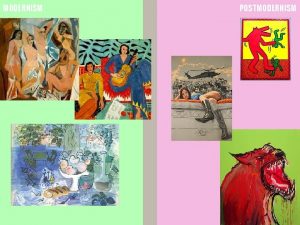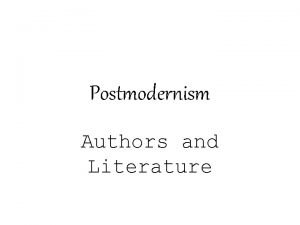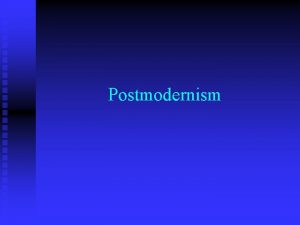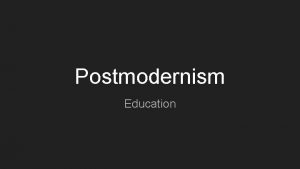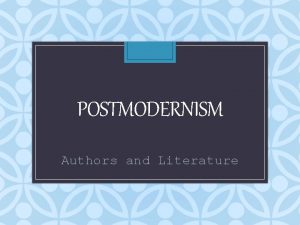POSTMODERNISM Research Part 1 2 Postmodernism is the






- Slides: 6

POSTMODERNISM Research Part 1 & 2 “Postmodernism is the term used to describe the use of a late 20 th century style and concept in the arts, architecture, and criticism, which represents a departure from modernism and is characterized by the self-conscious use of earlier styles and conventions, a mixing of different artistic styles and media, and a general distrust of theories. ”

Post-Modern Media Texts Post modernity through the use of Film implies significantly a hyper-reality culture of the present time of society. Furthermore, producers of experimental films use existing media texts from other art forms e. g. magazines, music etc. changing an original slightly to the construction of our culture more suitably. Postmodernism allows producers to challenge conventions, forms and ideologies of existing genres, therefore, doesn’t particularly fit into any genre due to the range of art forms they include. In addition, producers may use images to imply something about society subconsciously through film production, for example – Banksy and sociologist Strinati’s fact about the Mona Lisa being re-produced several times in different ways by Andy Warhol through pop art. Both of these images to the left both reflect a lot about society through their use of postmodernism – in particular, the Banksy photo. The idea could potentially be used through films to describe the acceptance of gay marriage in society, and how our culture has become equalised. Furthermore, now-a-days we now see more gay people and witness gay relationships as an audience in film, so this image of Banksy truly reflects this indication.

Challenging Meta-Narratives An aspect in Post-Modern media includes the concept of “Challenging Meta-Narratives”. This means producers challenge the main ideologies in society. The term was brought into prominence by Jean-François Lyotard in 1984. These narratives question whether modern progress is for the “good” of society, a critique of society/ mass production. Additionally, these narrative themes can often challenge conventional film narratives where they’re anti heroes that have unclear representations and furthermore, a female character may be the main character and see as strong, rather than there be a male dominant figure e. g. Salt, where Angelina Joli is our main character. Lastly, included in this aspect are non-linear narratives (disruption of the chronology of the three act structure e. g. Kill Bill, alternatively anti narratives which include disruptions by using freeze frames and slow motion – Sherlock Holmes in fight, boxing scene, and finally, mixing the genres in films to create new hybrids. Post-Modern Aspects Intertextuality and Pastiche To use Pastiche or Intertextuality means to offer updated ideas from the origin of old ideas. The idea of relating to other media texts is for effect to it’s audiences, creating a hybrid genre. The notion was first introduced by Julia Kristeva, who argued against the concept of a text as an isolated entity which operates in a self-contained manner that states that “any text is the absorption and transformation of another”. Some texts do refer directly to another, like for example, remakes of The Simpson's parody’s, reflecting our society more presently. By referring to other media texts, it does give audiences many pleasures; it reminds us we are in a mediated reality, relating to the dominant realist tradition which focuses on persuading the audience to believe in the on-going reality of the narrative. https: //www. youtube. com/watch? v=FWKFk. NFs. GBw Hyper Reality Basically, Hyper Reality through media texts is a hyped up, over the top, and occasionally unrealistic representation of our modern day culture, which comes across as a constructed piece (breaking the 4 th wall ideology (Meta Reference) – e. g. Alfie – talking to the audience through the camera https: //www. youtube. com/watc h? v=B 0 FZh. Le. Hy 7 A). This concept makes audiences aware of alternative realities that challenge our ideas. They have High Art Styles which are film techniques that challenge conventional ideas. Simulacra which allows challenging themes and representations to be explored. The media dominate our perception of the outside world – representing a world that is more real than which we can experience individually (which intertextuality and pastiche is often used for).

http: //curnblog. com/2014/04/10/br eaking-fourth-wall-alfie-wolfwall-street/ This relates to HYPER REALITY of the Meta Reference. Angelina Joli – Salt. I have used this example as it strongly supports an aspect of Post Modernism that experimental films, that don’t fall into any particular genre due to the INTERTEXTUALITY that they include. This film’s producer challenges the conventions of the character representations of the narrative of not having a macho male as the dominant, main character, however using a female character that has similar characteristics of the male character we would already have been familiar with. As we can see by the photo, not only does it show by the focus and determination through her eyes that she is a strong, powerful character, but the anti narrative used around it, with the use of freeze frames, slow/fast motion of a NON-LINEAR narrative. This is very Post Modern. EXAMPLES The photo above is a PARODY from Family Guy of Star Wars. As you can see, the old idea have been updated by new modern day popular texts. Giving huge effect to its audience, it reflects that our society is hugely mediated. Quentin Torentino is one of the most well known producers for his use of post modernity in his experimental film making. His film “Kill Bill” not only has a CHALLENGING METANARRATIVE of having dominant female heroes/ characters, but he plays homage to other films, and includes all types of different genres like crime, western, martial arts, thriller, comedy aspects throughout the film to its audience. It also has a non-linear narrative with its slow motion and freeze framing, reinforcing the hyper reality of post-modern films. “I steal from every single movie ever made. If people don’t like that, then don’t go and see it. Alright? I steal from everything. Great artists steal, they don’t do homages. ” Quentin Torentino.

GENRE “A style or category of art, music or literature. ” As audience members, we use the term genre to categorise a film into a specific type of film, including either: Romance, Western, Comedy, Crime or even a mix of two genre’s known as a “hybrid genre”. Although the term “genre” seems like an easy, understandable term to use, it’s flexibility isn’t often recognised. Genre was originally used by a resistole in Ancient Greek theatre to establish a certain “quality control” over types of play where deviation was discouraged. There a range of different theories around the definition which are as followed on the slide 6. The Post-Modern theory allows producers to challenge this which is why there is now suc things as hybrid genres – mixing and using a generic way of conventions: intertextuality

Genre Theories Nick LACEY suggests that genre is a negotiation between producers and audiences. Hence genre has evolved by establishing “sub genres”, mixed genres or “hybrids”. Charles PIERCE looked at fixed meanings of iconic signs. ADORNO and HORKHIEMER, two European critics of Hollywood, stated that mass production of film create a repetitive ‘standardisation’ of conventions dominated with one ideology. (The American Dream) The relation to these theories and Tarintino films is arguably different. Due to Tarintino’s films being hugely experimental, consistently challenging the typical conventions of film in a Post-Modern way, Nick Lacey’s theory does link into the work of Tarintino himself. Lacey states that “genre is a negotiation between producers and audiences… hence genre has evolved by establishing “sub genres” mixed genres or “hybrids”. Tarintino films have a mix of more than two sub genres, although the main genre would arguably be Martial Arts. It does include elements of romance, western (showdowns where our lone hero seeks revenge, crime, thriller and comedy. He also makes references to many other films (known as intertextuality) through his own films as he wants audiences to be more active in reading iconography and ideologies in his films: INFLUENCES – https: //www. youtube. com/watch? v=J 0 Brd. Mi-oyc&feature=player_detailpage (The Good, the Bad and the Ugly – Showdown) https: //www. youtube. com/watch? v=50 Ov. Iqkd. Nq 4 (Bruce Lee Game of Deaths Music Video)







